10 Yoga Poses to Help Relieve Shoulder and Neck Pain
January 28th 2021
In an age when most people spend a good chunk of their week hunched over a screen, neck and back issues are becoming some of the most common ailments that people deal with. While preventative measures like better desk setups are the best approach, there’s only so much that can be done.
Luckily, yoga brings a host of new solutions to the modern physiological problems. Here are the 10 best poses for tackling shoulder and neck pain that you can do every day to alleviate any symptoms.
Why Do My Shoulders and Neck Hurt?
Shoulder and neck pain usually results from injury to the soft tissues in the upper region of the body. This can result from whiplash, inflammation, physical stress on these areas, emotional stress leading to stiffness, arthritis, or sitting still for too long. Physical injury may also result in long-term soreness.
You should always consult a doctor if you have extensive pain, but you can also take steps to make your lifestyle healthier and
manage mild pain. This includes plenty of rest, hot and cold compresses, elevation, and muscle relaxation.
One way to relax your muscles is through yoga - that’s because this physical activity is intense enough to keep you moving, but gentle enough to prevent further strain. Before you get started, here are some primary types of shoulder and neck pain.
Types of Shoulder and Neck Pain
There are many causes of shoulder and neck pain that can affect your body to varying degrees. They include the following.
Neck Pain
- Cervicalgia - Resulting from poor posture and/or long term stress, this injury affects the cervical spine (the part of the
neck that supports the head). Stiffness and spasms are two of the symptoms, and stretching is one way to help manage
this issue. - Neck sprain - This usually results from repeated physical strain and heavy physical activity, which is why it’s most common with athletes. Symptoms include stiffness, dizziness, and fatigue.
- Shoulder pain from sleeping - If you sleep in an uncomfortable position, you can get short-term shoulder pain. Even though it might not last for a long time, treating it promptly is vital.
- Pinched nerve in the neck - Formally known as cervical radiculopathy, this results in symptoms like radiating pain and muscle weakness. Physical therapy, stretching, and yoga can all help ease the symptoms.
- Torticollis - Resulting from muscles that are tighter from one side than another, torticollis usually means you tilt your head on one side more than the other. This can be treated by doing stretches and yoga poses to exercise the muscles on the other side of the neck.
Shoulder Pain
- Shoulder tendonitis - This results from an inflamed rotator cuff where the muscles and tendons are found in the shoulder. It results from shoulder overuse from running and other sports.
- Shoulder arthritis - Damage to the cartilage within the shoulder joint usually occurs on the glenohumeral joint, or the large ball-and-socket joint. It occurs over time due to stress.
- Subacromial impingement - One of the most common shoulder problems, this occurs when tendons around the shoulder cuff become irritated.
10 Yoga Poses to Help Relieve Shoulder and Neck Pain
If you’re ready to be free of the pain you’re holding in your shoulder and neck, one common way to alleviate your discomfort is yoga. There are certain yoga positions that actually focus on this area.
Yoga is especially important if you’re an athlete or training for a marathon. SportMe has the perfect app for runners looking to improve their pace. It's a world class training plan and coach tailored just for you and your goals, developed by the professionals at SF AppWorks. But it’s also important to make sure your body can heal in between these workouts to ensure your safety and allow you to perform at your best once the date is upon you.
1. Ear to Shoulder/Neck Rolls
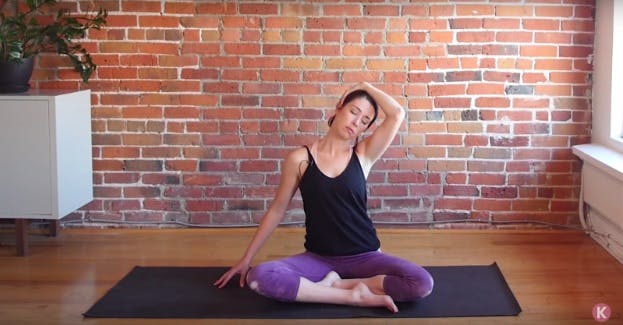
Probably the most popular and well known stretch for relieving neck tension, the yoga equivalent takes it a little bit further. First, make sure you’re in a comfortable seat with your hands resting on your knees. Sit upright and relax your shoulders, and push your chin against your chest to straighten your spine. Next, gently roll your head to the right or left until your ear touches your shoulder - use one hand to push your head, and the other to slowly push your opposite shoulder in the other direction.
Slowly roll your head back to the center and then repeat on the opposite side. You’ll immediately start to feel the muscles in your neck being stretched, which will feel quite nice if you’re stiff.
This is an extremely delicate stretch that doesn't require a serious amount of pressure - the opposing stressors and the sensitivity of neck and shoulders muscles will make you feel it right away.
2. Seated Forward Bend
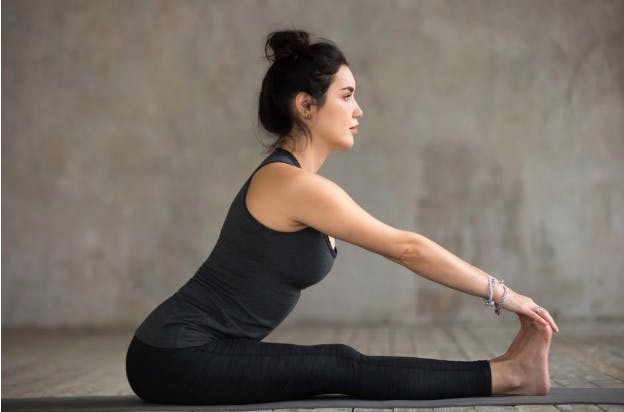
For the seated forward bend pose, sit upright with your legs aligned exactly straight. Take a deep breath inwards and fold forward, trying to cup your heels - make sure your chest touches your knees, or comes as close as possible. Now, here’s the important part - tuck your chin inwards while rolling forward, and hold that stretch, while slowly pulling your shoulders in.
Count slowly to five, exhale, and pull back out. This is a great pose because it’s intended to align your neck with the forward, natural motion of your upright spine.
In fact, this pose comes with a lot of benefits. It stretches the spine, shoulders and hamstrings. It also is known to improve digestion, stimulate the liver, kidneys, ovaries, and uterus, and help relieve symptoms of menopause and menstrual discomfort. It also helps with headaches, anxiety, and fatigue.
3. Cross Body Shoulder Stretch
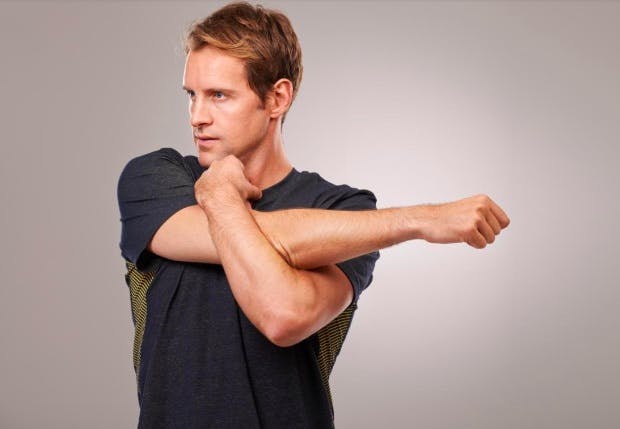
Another classic stretch, this pose is wonderful for releasing tension in your shoulder muscles-- especially when a yoga breathing pattern is incorporated. Muscle tension in the deltoids and triceps are a common reason for your shoulders/trapezius clenching together, and this pose can aid in releasing the entire system.
As always, start off in a comfortable upright seated position, and gently pull your arm across your body until you feel a stretch in your shoulder. Hold this stretch for at least 3 breaths (inhale and exhale), then release, and switch to the other shoulder. This is an easy pose to do anytime during the day (vs just during a Yoga session), since you can do it from almost anywhere and it brings near instant relief.
4. Warrior II Pose
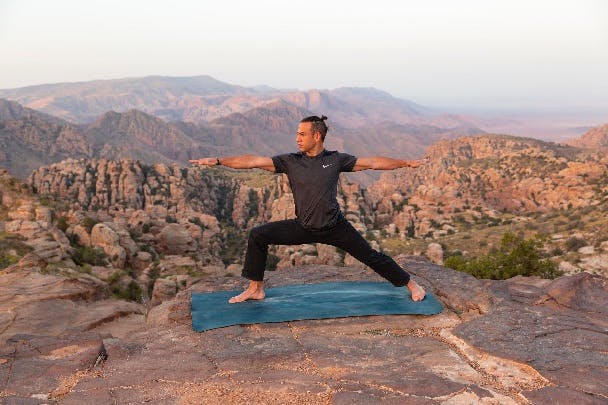
This is a fantastic pose that’s primarily focused on releasing your chest and shoulders, which then indirectly forces your neck upright - three birds with one stone! (Or a slightly more morbid, less morbid saying).
From a standing position, bring one foot back and another foot forward in a slightly slanted V shape (align the heel of your back foot with your front foot). Then, slowly, lean into your front foot while bending that knee (thereby stretching your back foot). While doing this, slowly lift both your arms and spread out your entire wingspan - one hand facing your front foot, the other towards your back. Hold the pose for 30 seconds, then flip.
5. Two-Footed Pose
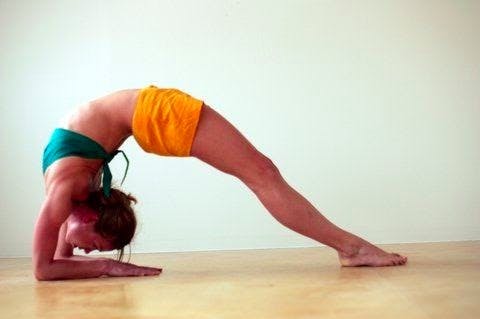
This is one of those rare poses that does a great job at addressing two completely separate musculoskeletal regions. It not only strengthens the legs, but increases spinal flexibility, opens the chest and shoulders, and is known to even soothe the mind.
First lie on your back with your arms extended on your side, palms down, and keep your feet flat on the floor with your knees bent. Then slowly inhale and raise your butt off the floor, keeping your feet and palms where they are.
It's important to keep your chin tucked into your chest this entire time and not move your head at all during the movement.
Hold the post for three or four breaths and then exhale downwards.
This is a fantastic pose, not only for neck alignment and shoulder release, but also for your pelvic area and can be a great core strengthening workout.
6. Cat/Cow Stretch
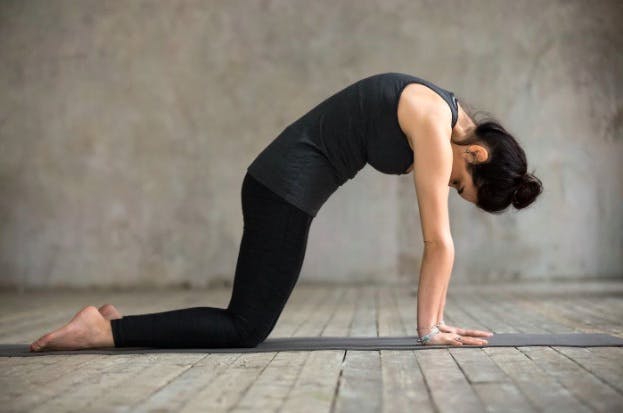
Not the most flattering stretch (either in name or in movement), but this pose directly targets and stretches both your neck and shoulder muscles. This pose also stimulates and strengthens the abdominal organs, opens the chest, and helps you achieve slow and deep breaths.
Start in tabletop position with your back arched and look up at the ceiling (cow position) - then, slowly, round your back and shoulders forward and lower your chin until its nearly touching your chest (cat position). Alternate on inhale/exhale for at least 8 breaths.
7. Standing Forward Bend Pose
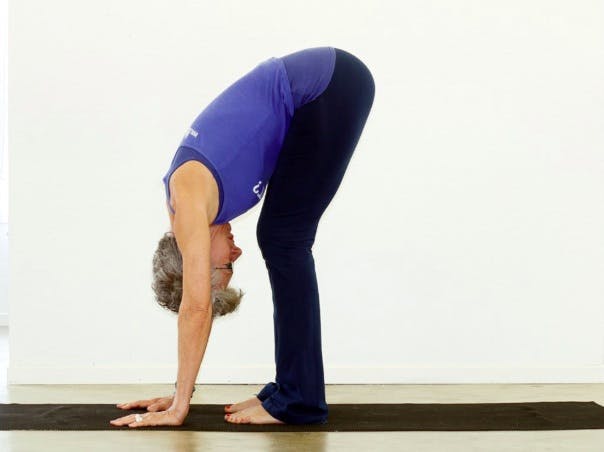
This is one of the most foundational yoga poses you'll see in any beginner yoga class - and for good reason. It’s a wonderful way to correct rounded shoulders and generally release neck and shoulder tension. It also stretches the hamstrings, calves, and hips.
But it has so many more benefits than that, making it the perfect staple to any yoga session. It calms the brain and helps relieve stress, stimulates the liver and kidneys, strengthens the thighs and knees, and even improves digestion.
It’s also known to relieve menopause symptoms, reduce anxiety, and give you relief from headaches and insomnia.
Start off standing at an upright position, with your feet aligned facing forward. Tuck your chin to your chest and slowly roll downwards, gradually moving lower until your hands touch your feet - hold that stretch and slowly exhale.
Gradually come back up and repeat - its important that the rolling motion to the floor happens gradually, attuned to your breath, and your chin is tucked in at all times.
8. Hand Clasp Behind Back
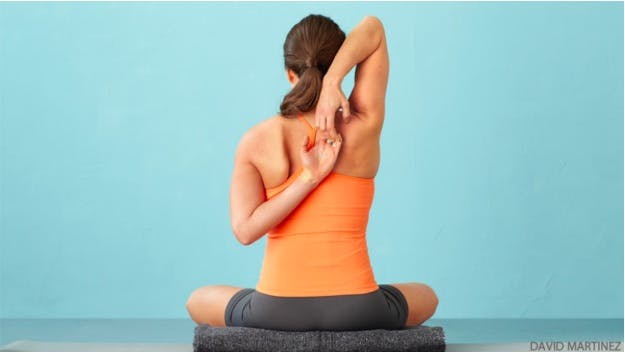
Another beginner pose, this is extremely good for people with tight shoulders or any kind of pain in the shoulder blades. Simply put, you stand upright and interlock your hands behind your back, then straighten your arms as far as you can while gripping tight. For an extra stretch to your neck while doing this, tuck your chin into your chest as hard as you can.
You can adjust this pose depending on the severity of the tension on your shoulders by simply gripping harder or softer.
9. Melting Heart Posture
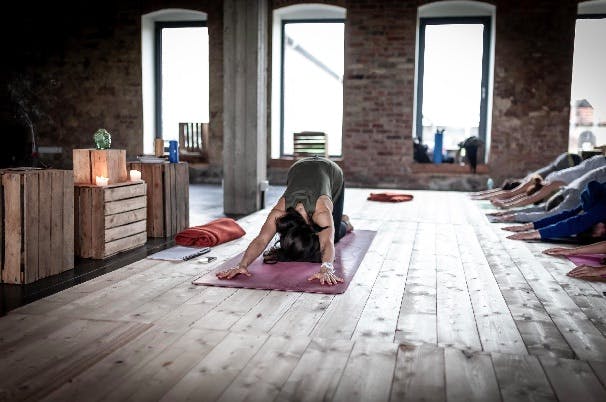
This is an advanced pose that might be difficult for people who are still building up their flexibility. If you can hit it, though, it delivers a remarkable stretch to your entire neck, shoulder and upper back and is simply fantastic at releasing soreness and tightness.
You’re also rewarded with the rounding of the spine and increased shoulder mobility. This pose is known to stimulate the urinary bladder meridian through the compression of the spine, as well as the stomach and spleen meridian in the chest. If your arms are extended, it can also stimulate the lung and heart meridians.
So, simply put, you stretch forward on all fours as far as possible while keeping your legs in a 45 degree angle at the knees, and create as much of a curve in your back as possible. This is entirely a comfort game - the more of a stretch you can safely do, the better it is for you.
10. Sphinx Pose
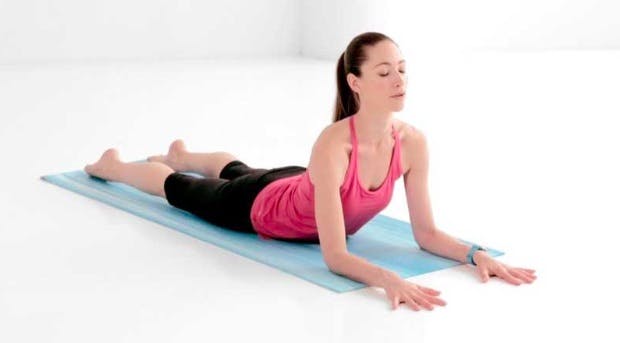
Another classic, the Sphinx pose is a good alternative to the melting heart for beginners. Simply lie down flat on your stomach with your palms facing down, shoulders on a 45 degree angle. Keep your legs entirely flat, then slowly raise your head and lift your upper torso as high as you can - this stretches out your entire back, and the further up you go the more your neck is
stretched out as well. Once you're looking straight ahead, hold the post for a minute or 2 (or as long as you can).
Consider complimenting this with the cat/cow pose to make sure you aren’t adding tension to your neck by only moving it a single direction.
These are just some of the poses you can learn to help with back, shoulder and neck pain, or help relieve some tension after a good run.
If you’re a runner, download the SportMe app, developed by SF AppWorks, a digital agency that offers custom software development solutions. You’ll get a world class training plan and coach tailored just for you and your goals.
Related: Can’t Run? Think Again
